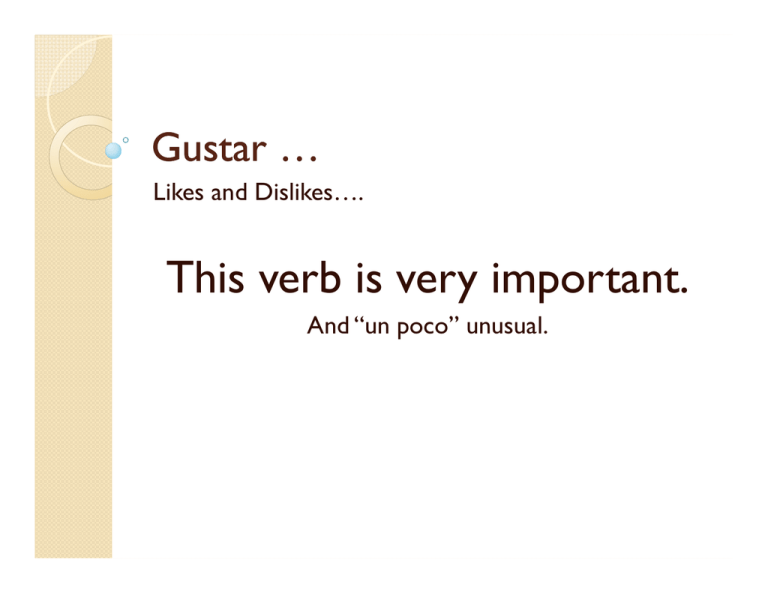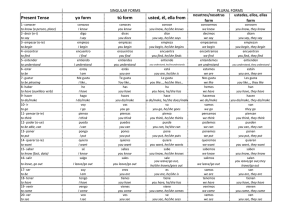This verb is very important.
Anuncio

Gustar … Likes and Dislikes…. This verb is very important. And “un poco” unusual. GUSTAR En ingles, significa “to like” En español, significa “to be pleasing” In English, we say “I like pizza” In Spanish, we say “the pizza pleases me” Subject and Verb I like pizza … in English, “I” is the subject … like is the “verb” …pizza is the “direct object” In Spanish, we say… ◦ Pizza pleases me. …or “to me, pizza is pleasing” “Pizza” is the subject… “pleases” is the verb … “me” is the indirect object Word order is reversed.. Using the verb “Gustar” We start by deciding “the thing” that pleases us (is pleasing to us) Next, decide who likes it… I like … me gusta(n) You (familiar) like … te gusta(n) You (formal), he, she likes … le gusta(n) We like … nos gusta(n) You guys (in Spain) like… os gusta(n) You guys, they like … les gusta(n) The thing that is pleasing If the thing that we like is singular (or another verb)… use “gusta” ◦ I like pizza … me gusta la pizza. ◦ I like to eat …. Me gusta comer. If the thing that we like is plural, we use “gustan” ◦ I like books… me gustan los libros. ◦ I like pretty houses… me gustan las casas bonitas. Clarifying “who” likes it… Because “le gusta” can mean you, he, or she likes… we have to clarify the “who” ◦ ◦ ◦ ◦ ◦ ◦ A mi, me gusta … A ti, te gusta A usted / a él / a ella, le gusta A Tom / a Susana, le gusta A nosotros, nos gusta (a Tom y yo, nos gusta) A ellos / a ellas / a ustedes les gusta A Tom y Susana les gusta “Clarifiers” … to clarify “who” likes the object Me = a mí Te a ti Le = = a él a ella a Ud. (a Roberto) (a Lola) (a tu hermano) Nos = a nosotros Os = a vosotros Les = a ellos a ellas a Uds. (a Roberto y a Luis) (a Lola y a Carmen) (a mis amigos) Gustar Constructing the Sentence To emphasize Object – the Form of person who Gustar “is pleased” Subject (A verb) Subject (the thing that is pleasing) Infinitive Singular Noun Plural Noun Practice… I like dogs. Do you like to eat Mexican food? She likes “espagueti”(m) Tom and I like to swim (nadar) Bill and Maria like vegetables.


